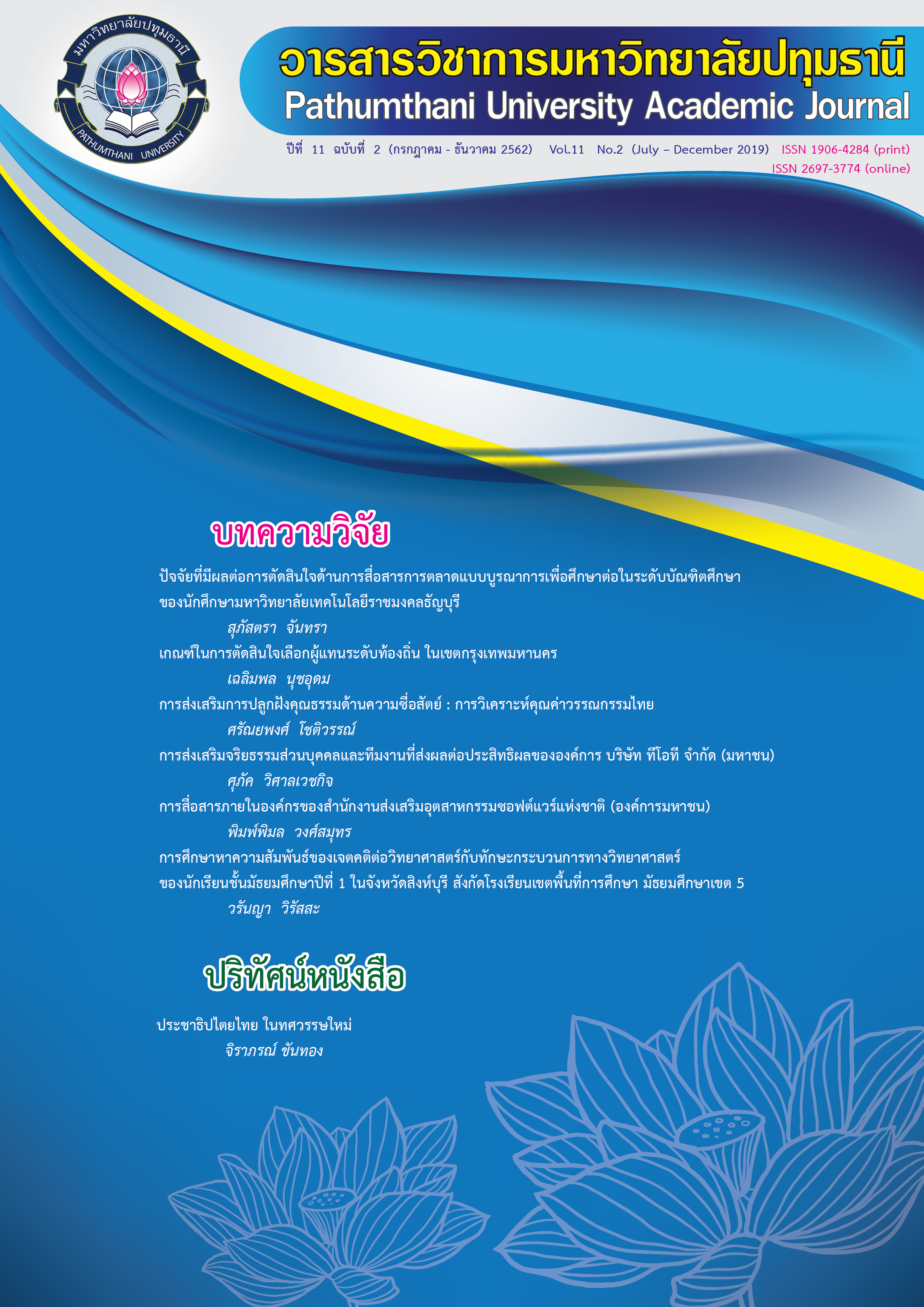The Effects of Psychological Environment Factors on Organizational Commitment: A Case Study of Government Officials at the Ministry of Labour
Keywords:
Motivation to work, Job feature recognition, Organization atmosphere, Commitment to the organizationAbstract
In this thesis, the researcher investigates (1) Study the level of environmental psychological factors, such as motivation to work. Job recognition Organizational atmosphere And commitment to the organization Of the Ministry of Labour. (2) To study the relationship between psychological and environmental factors, including motivation for work. Job recognition Organizational atmosphere And commitment to the organization. Of the Ministry of Labour. (3) To study the power of predicting environmental factors in psychology. Job recognition Organizational atmosphere And commitment to the organization. There are at least 1 variable of the Ministry of Labour. The sample of this research was the Ministry of Labour. Central government (Office of the Permanent Secretary for Labor) and Regional Office The Provincial Labour Office (241 persons) The instruments used in the study were questionnaires on personal factors. Work Motivation Questionnaire Job performance questionnaire Organizational climate and the organizational commitment questionnaire. Statistics used in data analysis were percentage, mean, standard deviation. Pearson Product Moment Correlation Coefficient Multiple regression analysis using Forward Selection technique. Findings are as follows: 1. The conscientiousness motivation to work Job recognition Organizational atmosphere Relationship with organizational commitment of the Ministry of Labour. Statistically significant level of .05. 2. The conscientiousness Job recognition Organizational atmosphere Can jointly predict organizational commitment of the Ministry of Labour. level of .05, both variables could predict organizational commitment by 44.50 percent. Predictably the best organizational commitment.
References
ฎัชวรรณ อุดมชัยรัศมี. (2543). การศึกษาเปรียบเทียบความพึงพอใจในงานและความผูกพันต่องานระหว่างพนักงานที่มีการรับรู้คุณลักษณะงานแตกต่างกัน. วิทยานิพนธ์ศิลปศาสตรมหาบัณฑิต, มหาวิทยาลัยธรรมศาสตร์.
เทพนม เมืองแมน และสวิง สุวรรณ. (2540). พฤติกรรมองค์การ. (พิมพ์ครั้งที่ 2). กรุงเทพมหานคร: สำนักพิมพ์ไทยวัฒนาพานิช.
นิณี บุณยฤทธานนท์. (2547). ปัจจัยที่พยากรณ์ความผูกพันต่อองค์การของพนักงานเอกชน. การค้นคว้าแบบอิสระวิทยาศาสตรมหาบัณฑิต, มหาวิทยาลัยเชียงใหม่.
พงษ์จันทร์ ภูษาพานิชย์. (2546). ออกแบบงานอย่างไรเพื่อสร้างแรงจูงใจภายในงาน. มนุษยศาสตร์สาร. ปีที่4 (ฉบับบ1), 1-12.
ศิริวรรณ เสรีรัตน์, สมชาย หิรัญกิตติ, สุพีร์ ลิ่มไทย, ณกมล จันทร์สม, ลัทธิกาล ศรีวะรมย์ และอารี พันธ์มณี. (2541). พฤติกรรมองค์การ. กรุงเทพมหานคร: สำนักพิมพ์ธีระฟิล์มและไซแท็ก.
Hackman, J. R., & Oldham, G. R. (1980). Work redesign. Reading. MA: Addisson-Wesley.
Herzberg, F., Mausner, B., & Synderman, B. B. (1959). The motivation to work. New York: John Willey & Sons.
Maslow, A. H. (1970). Motivation and personality. (2nd ed.). New York: Harper and Row.
Rollinson, D. (2005). Organisational behaviour and analysis: An integrated approach. Englewood Cliffs. NJ: Prentice Hall.
Sheldon, M. E. (1971). Investment and involvements as mechanism producing commitment to the organization. Administrative Science Quarterly, 16, 143-150.
Steers, R. M. (1977). Antecedents and outcomes of organizational commitment. Administrative Science Quarterly. 22, 46-56.
Yamane, T. (1973). Statistics: An introductory analysis. (3rd ed.). New York: Harper & Row.
Downloads
Published
How to Cite
Issue
Section
License
บทความที่ได้รับการตีพิมพ์เป็นลิขสิทธิ์ของวารสารมหาวิทยาลัยปทุมธานี
ข้อความที่ปรากฎในบทความแต่ละเรื่อง เป็นความคิดเห็นส่วนตัวของผู้เขียน กองบรรณาธิการไม่จำเป็นต้องเห็นด้วยเสมอไป และไม่มีส่วนรับผิดชอบใด ๆ ถือเป็นความรับผิดชอบของผู้เขียนแต่เพียงผู้เดียว



